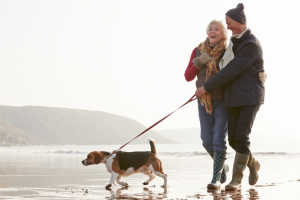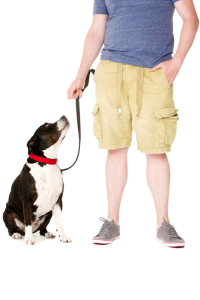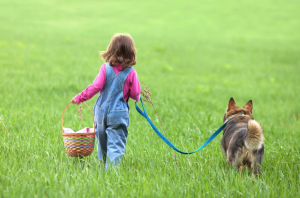 How wonderful is it to take a nice stroll in the park with our dog? We’re enjoying the cool breeze in our hair, the sound of birds in the trees and just sharing a nice stress releasing moment with our canine friend. Walking the dog has been shown to have many benefits both physical activity and mental stimulation (for more on the subject, go to “Walking the dog has big impact!”) For many dog guardians however, walking Fido is much more a chore than it is a relaxing experience. It’s hard to have a good time when our dog is pulling like a freight train, frantically sniffing that patch of grass to the right, then running to the left and chasing after every squirrel, while we’re painfully hanging onto the end of the leash. Big or small, most dogs will pull unless we take the time to teach them otherwise. Teaching any dog to pay attention to us and keep slack in the leash is easy once we understand and apply some of the basic principles at play. Loose leash walking is however one the hardest skills to master, as it requires from us patience and consistency, two qualities that are easily influenced by our mood, our level of fatigue and our motivation of the moment. Let’s look at some of the fundamental principles at play and go over a few of the most effective techniques.
How wonderful is it to take a nice stroll in the park with our dog? We’re enjoying the cool breeze in our hair, the sound of birds in the trees and just sharing a nice stress releasing moment with our canine friend. Walking the dog has been shown to have many benefits both physical activity and mental stimulation (for more on the subject, go to “Walking the dog has big impact!”) For many dog guardians however, walking Fido is much more a chore than it is a relaxing experience. It’s hard to have a good time when our dog is pulling like a freight train, frantically sniffing that patch of grass to the right, then running to the left and chasing after every squirrel, while we’re painfully hanging onto the end of the leash. Big or small, most dogs will pull unless we take the time to teach them otherwise. Teaching any dog to pay attention to us and keep slack in the leash is easy once we understand and apply some of the basic principles at play. Loose leash walking is however one the hardest skills to master, as it requires from us patience and consistency, two qualities that are easily influenced by our mood, our level of fatigue and our motivation of the moment. Let’s look at some of the fundamental principles at play and go over a few of the most effective techniques.
Why do dogs pull? What would motivate a dog to put all their weight against the collar or harness, even to the point of restricting their airway? The dog is just trying to go forward, to explore the world and take advantage of the opportunity for fun and stimulation, that’s the motivation, the driving force behind the behavior. Pulling forward leads to moving forward. It’s basic operant conditioning: putting pressure on the leash is positively reinforced by every step in the desired direction. And judging by how much discomfort they’re willing to put themselves through, moving forward is of very high value. So the key to success is making sure that pulling is no longer rewarded, not even for a brief moment. We need to teach the dog that paying attention to us, and synchronizing his/her movements with us, is rewarding. Pulling should not work.
The other force at play in this situation has to do with the opposition reflex. As defined by Pavlov (1849-1936), the opposition reflex, also called thigmotaxis, refers to the instinctual response of any living creature to push against or away from physical contact or from any force applied in their direction. If someone pushes us, we push back. It’s a natural, unconscious reflex. In the same way, when the dogs feel pressure on their neck, their natural instinct is to pull against that pressure. So when teaching the dog to walk on a loose leash, it will be important to address this natural reaction.
So we’ve identified why dogs tend to pull on their leash, but how do we teach them otherwise? I’ve used pretty much every training technique available over the many decades I’ve been training professionally and have found that what works best, is using a clicker to mark the desired behaviors and treats to reward them. Other methods involve using leash jerks whenever the dog gets out of position. The problem with those techniques is that we cannot control what other things the dog will also learn. Through classical conditioning, the dog could make the association between seeing other dogs and getting a correction, seeing other people and getting a correction, or worse, being close to us and getting multiple corrections. In addition, jerks to the neck may cause injuries to the dog (for more on the subject, go to “Choke collars, prong collars or flat collars are harmful training tools”). One of the big advantages of using a clicker and treats (or even just treats) is that we’ll teach the dog that paying attention to us, and walking by our side is fantastic!
 As with any other training, it’s important to set the criteria before we start. Here are the three behaviors that we want to encourage:
As with any other training, it’s important to set the criteria before we start. Here are the three behaviors that we want to encourage:
- Looking at us, because we need the dog to pay attention to where we go;
- Putting slack in the leash;
- Walking by our side. Since I train mostly service dogs, I’m looking for the dog to be in a heel position, but this criterion can be modified depending on what you’re trying to accomplish.
As we walk with the dog, we’ll want to click and treat for any of these behaviors. When we first get started, we’ll make sure to click and treat very often. Most of us struggle with being to too stingy, for best results, frequent rewards will help the dog understand which behaviors work. As the dog is successful, we’ll gradually increase our criteria, clicking and treating only when the dog is in position, on a loose leash while looking at us. We’ll also gradually increase the distance and time between the reinforcement until we can replace the treats with real life rewards (access to a favorite area, to another dog, a toy, etc). Finally, we’ll make sure to repeat this process in many different environments while slowly introducing increasing levels of distractions.
In addition to the method described above, here are several techniques that help the dog understand what works and what doesn’t. I use all of them at different times, as they complement one another and all contribute to a forming solid leash habits.
- Yielding to pressure: Since dogs naturally tend to push against the pressure on the leash, this method will teach them to do the opposite, in other words, to move with the pressure, not against it. This technique, also called ‘silky leash‘ by Grisha Sterwart, is directly inspired by horse training, where horses are taught to follow the feel of the reins, versus pushing against it. We start in a small and familiar room, to limit any desire to explore. With the dog on leash, we’ll pull very lightly in one direction or the other, just enough for the dog to feel a slight tug. We’ll wait and even move along with the dog until he/she makes any move in the direction of the pull. As soon as the dog releases the pressure, we click and treat. For best results, we’ll make sure to immediately release the pressure, adding to the reinforcement. After a few repetitions, once the dog shows intentional movements in the direction of the leash, we can gradually increase the criteria and the level of difficulty, moving to a larger room, taking more steps, going in the back yard, etc. For more on this technique, please refer to the blog ‘Yielding to pressure – From horses to dogs, an example of negative reinforcement’.
- Be a tree: Our goal here is to teach the dog that pulling does not work. Anytime the dog pulls, we stop moving forwards, we plant our roots. The dog will naturally keep trying to pull, but there is always a point where he/she turns around, looks back to check on us, and/or puts slack in the leash. Click and treat, then move forward again. With repetition, the dog will start looking at us and putting slack in the leash faster and faster. This method applies both negative punishment (we stop the forward movement, so we take away what the dog wants (-) to reduce the pulling (punishment)) and positive reinforcement (we click and treat for eye contact and slack in the leash (+) to increase both those behaviors (reinforcement)).
- Penalty yards: If moving forward is the reward, we can use this as a means to teach the dog to pay more attention to us. In this technique, we’ll use anything the dog wants to reach: a patch of grass, a treat or toy on the ground, a person they like, another dog, etc. As long as the dog synchronizes their speed with ours and keeps slack on the leash, we’ll keep moving forward. We’ll also click and treat anytime the dog turns and looks at us. If at any time the dog forges forward and puts tension on the leash, we immediately back up swiftly all the way to the starting point. By backing up swiftly, we encourage the dog to follow us, as he/she is more likely to be drawn towards us by our rapid movement. It’s important to allow the leash to slide through our hand as we back up, all the way to the end of the leash if needed. This will give time to the dog to respond to our change of direction while avoiding a sudden jerk to the collar. In this method, we simultaneously use both negative punishment (we take away the forward movement towards what the dog wants (-), diminishing the pulling (punishment)) and positive reinforcement by clicking and treating (+) for eye contact, reinforcing those behaviors.
 Back and forth: In this method, here again, our focus is to teach the dog to synchronize his/her movements with ours. The dog will learn that if he/she doesn’t pay attention to us, we’re likely to be walking in the opposite direction. As we walk forward, as long as the dog pays attention to us and synchronizes with our change of direction and speed, we keep moving forward, while clicking and treating as defined above. Anytime the dog forges ahead, putting tension on the leash, we turn around and start walking in the opposite direction. As we repeat this process, we’ll gradually be able to walk longer and longer distance in the same direction. Here we simultaneously use both negative punishment (we take away forward movement with the dog (-), diminishing the loss of focus on us (punishment), and positive reinforcement (click and treat for eye contact and position).
Back and forth: In this method, here again, our focus is to teach the dog to synchronize his/her movements with ours. The dog will learn that if he/she doesn’t pay attention to us, we’re likely to be walking in the opposite direction. As we walk forward, as long as the dog pays attention to us and synchronizes with our change of direction and speed, we keep moving forward, while clicking and treating as defined above. Anytime the dog forges ahead, putting tension on the leash, we turn around and start walking in the opposite direction. As we repeat this process, we’ll gradually be able to walk longer and longer distance in the same direction. Here we simultaneously use both negative punishment (we take away forward movement with the dog (-), diminishing the loss of focus on us (punishment), and positive reinforcement (click and treat for eye contact and position).
With regular repetition, all these methods will gradually teach a dog, at any age, to pay attention to us and walk on a loose leash. Over time, simply slowing down when the dog gets out of position will trigger Fido to quickly correct his position. Here’s the catch though. It’s important to follow through any time the dog is out on a leash. As long as the dog is allowed to pull when we’re not ready to put in the effort, the results will be limited. This also means that at first, we’ll have to give up on walking with our spouse or friend so we can focus completely on the dog until she’s ready for a nice relaxing walk. Isn’t years of great times with our dog worth a little effort up front?
Jennifer Cattet Ph.D.


Excellent article. Well written and emphases how NP and PR make a good training combo.
A good article as always – thanks!
My loose-leash program is similar to yours but, for dogs that wear collars, in the “Back and Forth” technique I always emphasize that the handler should stop and wait for a couple of seconds before proceeding in the other direction. If the dog is oblivious to the ‘stop’ and is at risk at coming to the end of the leash, waiting for a couple of seconds allows the dog to come to a stop on its own. This is preferable to the dog and handler moving in opposite directions at the same time, as I want to minimize any impact on the dog (especially those that wear collars). Of course a harness would be better, but many want to stay with collars (to which I insist upon using on a broad flat collar or properly fitted broad-banded martingale).
Great point. For the same reason, I teach owners to let the leash slide in their hands (given that they fold the leash to the needed length) as they’re walking in the opposite direction to give the dog some time to realize the change and react before hitting the end of the leash. In any case, however we work it out, effort should be made to avoid a sudden jerk to the collar or harness.